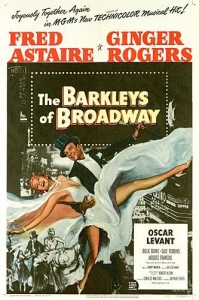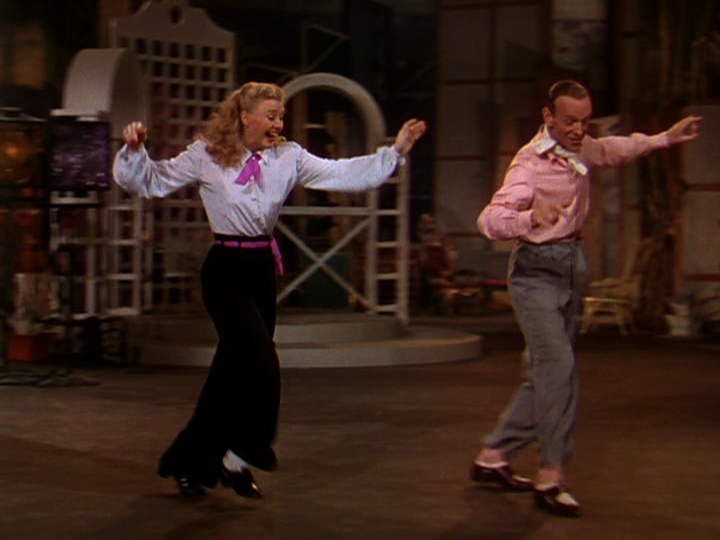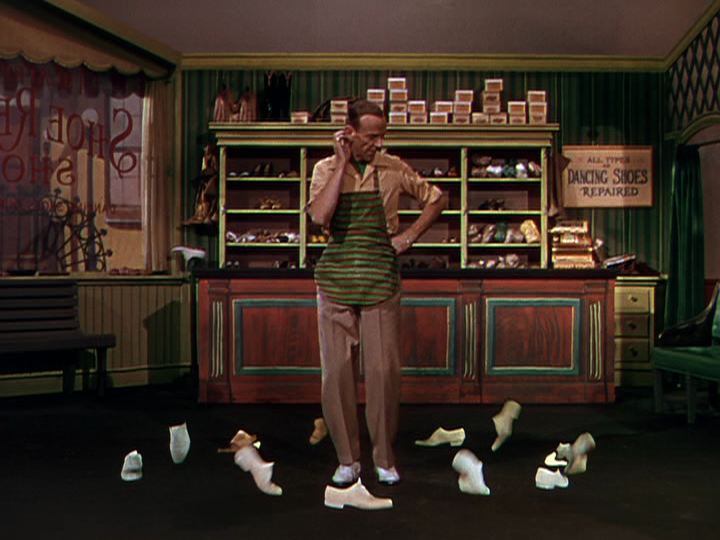“You’re wasted in musical comedy. You could be a great tragic actress!”
|

Synopsis:
Popular dancing duo Dinah (Ginger Rogers) and Josh (Fred Astaire) Barkley find their marriage and their joint career threatened when Rogers meets a French playwright and director (Jacques Francois) who leads her to believe that her true calling is serious drama.
|
|
Genres, Themes, Actors, and Directors:
- Actors and Actresses
- Fred Astaire Films
- Ginger Rogers Films
- Marital Problems
- Musicals
- Oscar Levant Films
Review:
Fred Astaire and Ginger Rogers’ tenth and final collaboration together (after a ten-year hiatus) was this innocuous Technicolor musical originally intended to reunite Astaire and Judy Garland after their successful pairing in Easter Parade (1948). Much has been made of the fact that Rogers was a little heavier here than in her earlier films with Astaire — a ridiculous complaint given that she dances wonderfully, and remains athletically trim. Indeed, Astaire and Rogers still sparkle while they’re dancing (either together or solo), and fans of the duo will surely be glad for one more chance to see their incomparable magic onscreen. Less easy to forgive is the lackluster script and premise (by Betty Comden and Adolph Green), which, as noted in All Movie Guide’s review, “is the kind of situation that Comden and Green [were] so adept at spoofing, but they’re asked to play it straight here.” Nonetheless, it is interesting to see how eerily the storyline echoes the “split” between Astaire and Rogers years earlier, when Rogers largely turned away from dancing and went on to forge an Oscar-winning career for herself as a “serious actress”.
Redeeming Qualities and Moments:
- Ginger Rogers as Dinah Barkley

- Some fine Rogers-and-Astaire dance numbers


- Astaire performing “Shoes With Wings On”

Must See?
No, though fans of Rogers and Astaire will certainly want to check it out.
Links:
|
One thought on “Barkleys of Broadway, The (1949)”
Not a must – in almost-complete agreement with what’s written.
~esp. re: the Comden-Green script. I won’t go so far as to say that “they’re asked to play it straight”.; much of their dialogue really is the way that actors talk (i.e., over-praising each other in public, fishing for compliments, insecure & dramatic…when they’re *not* on-stage). Still, the reins are held-in here, and that’s a shame – C&G are handling a more-or-less genuine love story…and that’s not their strength as writers. Worse…the subject matter of the play that is to prove Rogers’ worth as a dramatic actress – Sarah Bernhardt’s rise to fame as an actress (are they kidding?!) – is hardly stage-worthy.
There is one very clever idea in the script which gets some mileage – Astaire pretending, various times over the phone, to be the French playwright – but the bulk of the story is a disappointment (including the tedious sub-plot of Rogers’ understudy, which just doesn’t work at all).
Another major disappointment comes with Astaire’s ‘Shoes With Wings On’ number. Rather ingenious in design, the number comes suddenly undone when, for no reason at all (except that they didn’t seem to know how to end the piece), Astaire turns into a gun-wielding maniac (!), turning flashy invention into something suddenly disturbing.
If you’re going to watch it at all, you’ll be relieved that there are a few perks: Levant plays two classical pieces brilliantly: Khachaturian’s ‘Saber Dance’ (during which Levant is enjoying himself so much that he’s seen smiling!), and Tchaikovsky’s First Concerto. And, of course, Fred and Ginger are simply dazzling during Fred’s solo, ‘They Can’t Take That Away From Me’. So there’s compensation. And the film is very, very colorful – but it can’t paint over its flaws.